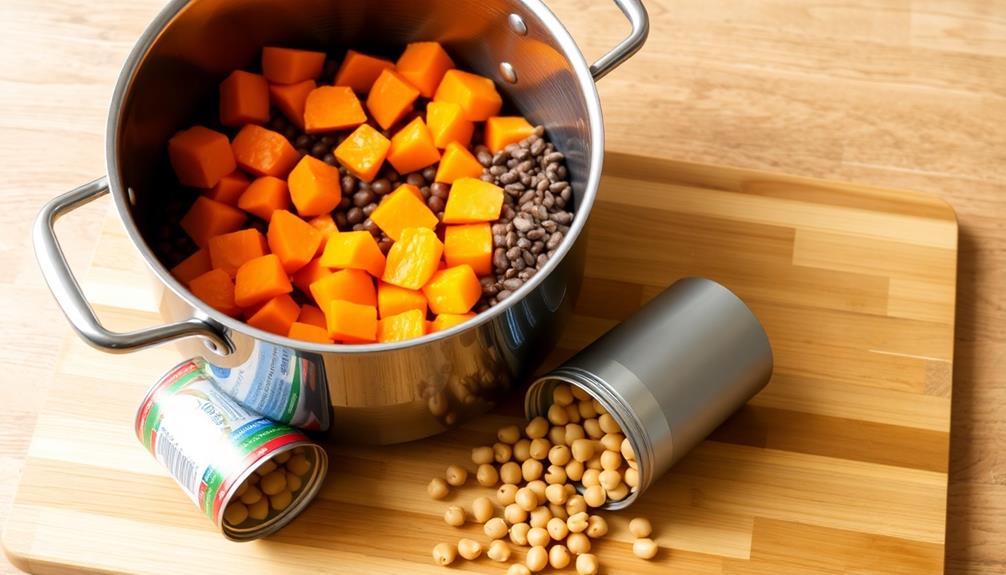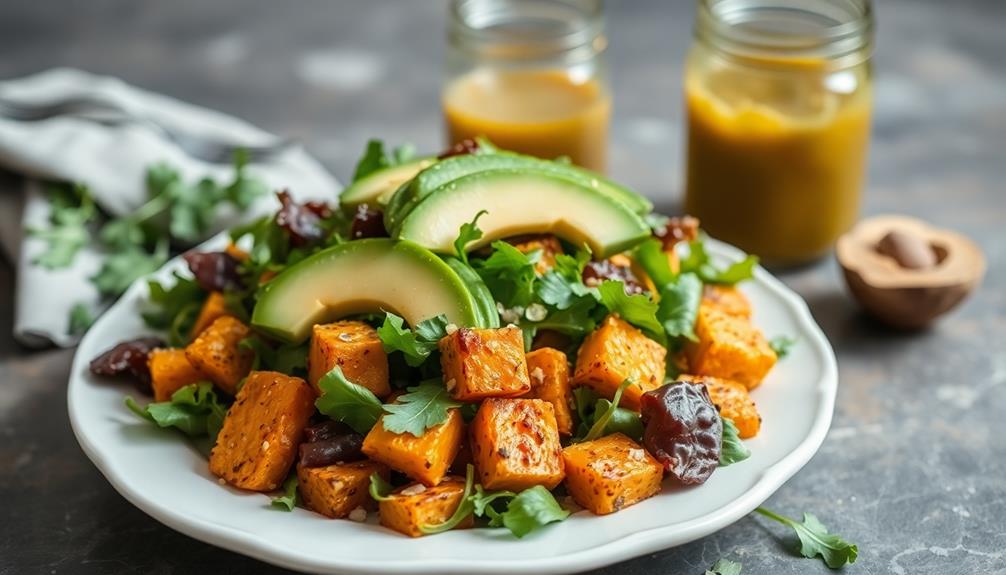As a vegetarian, you can enjoy nourishing and gut-friendly meals by embracing the low-FODMAP diet. This plant-based approach focuses on avoiding problematic carbohydrates that can trigger digestive issues. You'll discover a wealth of delectable recipes, like a lentil and sweet potato curry, packed with protein, fiber, and aromatic spices. Preparing these meals is straightforward, with simple steps like sautéing veggies, adding chickpeas or tofu, and serving over fluffy brown rice. By personalizing your low-FODMAP journey, you'll find the perfect balance of foods that satisfy your taste buds and support your overall well-being. Keep reading to uncover more mouthwatering options.
Key Takeaways
- The Low-FODMAP diet, developed at Monash University, is an effective approach for managing irritable bowel syndrome (IBS) and promoting better gastrointestinal health.
- Low-FODMAP vegetarian meals offer a plant-based, gut-friendly option, providing essential nutrients, fiber, and supporting overall well-being.
- A recipe for Lentil and Sweet Potato Curry showcases a simple, one-pot preparation with nutrient-dense ingredients and aromatic spices.
- Personalization is key, as individual responses to foods can vary, requiring adjustments and a food journal to identify personal tolerances.
- Meal planning, utilizing seasonal produce, and exploring new recipes can help ensure long-term success and enjoyment on a low-FODMAP vegetarian diet.
History
The origins of the low-FODMAP diet can be traced back to the late 1990s, when researchers at Monash University in Australia began investigating the effects of certain carbohydrates on gastrointestinal health.
They discovered that certain fermentable, short-chain carbohydrates, known as FODMAPs, could trigger digestive issues in people with irritable bowel syndrome (IBS) and other gut-related conditions. This groundbreaking research led to the development of the low-FODMAP diet, which focuses on limiting the intake of these problematic carbohydrates to improve gut health and alleviate symptoms.
Over the years, the low-FODMAP diet has gained popularity worldwide, becoming a widely-recognized approach to managing digestive disorders. Many individuals with irritable bowel syndrome (IBS) and other gastrointestinal issues have found relief by following a low-FODMAP diet. This eating plan focuses on reducing the intake of certain types of carbohydrates that can trigger digestive symptoms, and it has been shown to alleviate discomfort for many people. With increased awareness of the potential benefits of this approach, a growing number of food companies and restaurants are now offering satisfying lowFODMAP snacks and meals to accommodate individuals following this diet.
It's especially beneficial for vegetarians and vegans, who can struggle to find plant-based meals that are both nutritious and gentle on the gut.
Recipe
Lentil and Sweet Potato Curry
Warm and comforting, this lentil and sweet potato curry is a delicious low-FODMAP vegetarian meal. Packed with protein from the lentils and fiber from the sweet potatoes, it's a nutritious and satisfying dish. The aromatic blend of spices, including cumin, coriander, and turmeric, adds depth of flavor and a touch of heat.
Additionally, lentils are known for their health benefits, including high levels of antioxidants and vitamins, making this meal not only tasty but also beneficial for overall wellness.
This curry is easy to prepare and can be made in one pot, making it a great option for a quick weeknight dinner. The combination of lentils and sweet potatoes creates a hearty and filling meal that's sure to please.
- 1 cup dried red lentils, rinsed
- 2 medium sweet potatoes, peeled and diced
- 1 tablespoon olive oil
- 1 teaspoon ground cumin
- 1 teaspoon ground coriander
- 1 teaspoon ground turmeric
- 1 teaspoon salt
- 1/4 teaspoon black pepper
- 2 cups vegetable broth
- 1 cup canned diced tomatoes
- Chopped cilantro for garnish (optional)
In a large pot, heat the olive oil over medium heat. Add the cumin, coriander, and turmeric, and cook for 1 minute, stirring constantly, until fragrant.
Add the lentils, sweet potatoes, salt, and pepper, and stir to coat the ingredients in the spices. Pour in the vegetable broth and diced tomatoes, and bring the mixture to a boil.
Reduce the heat to low, cover the pot, and simmer for 20-25 minutes, or until the lentils and sweet potatoes are tender. Adjust the seasoning if necessary. Serve the curry warm, garnished with chopped cilantro if desired.
For best results, prepare the curry in advance and let the flavors meld together for a few hours or overnight. This dish also freezes well, making it a great option for meal prepping.
Cooking Steps
First, chop your veggies into bite-size pieces so they cook evenly.
Next, sauté the vegetables in a bit of oil until they're tender.
Then, add your favorite spices and seasonings to infuse the dish with flavor.
Finally, stir in some chickpeas or tofu for a hearty, protein-packed meal.
Serve it all warm over a bed of fluffy brown rice.
Step 1. Chop Ingredients Into Bite-Size Pieces

Chopping ingredients into bite-size pieces is a crucial step in preparing low-FODMAP vegetarian meals. This step ensures even cooking and makes the dish more enjoyable to eat. Use a sharp knife and cutting board to dice vegetables, fruits, and other components into uniform, bite-sized chunks. For example, chop carrots, zucchini, and bell peppers into 1/2-inch pieces. Dice tofu or tempeh into 1-inch cubes. Break mushrooms into quarters or halves.
Cutting ingredients to a similar size helps them cook at the same rate, preventing some parts from becoming overcooked while others remain undercooked.
Take your time and focus on safety when chopping. Keep your fingers curled under and use the "claw" grip to guide the knife. Be mindful of your knife's position and keep it controlled at all times.
Chopping ingredients into uniform, bite-sized pieces creates a pleasant texture and presentation, making your low-FODMAP vegetarian dish both nutritious and delightful to enjoy.
Step 2. Sauté Vegetables in Oil

After chopping the ingredients, it's time to sauté the vegetables in oil. This crucial step helps to bring out the natural flavors and aromas of the veggies.
Start by heating a large skillet or wok over medium-high heat. Once the pan is hot, add a drizzle of olive oil or your preferred cooking oil. Carefully add the chopped vegetables, making sure not to overcrowd the pan.
Sauté the veggies, stirring frequently, until they become tender and lightly browned, about 5-7 minutes. Remember to adjust the heat as needed to prevent burning. The key is to create a nice sear on the vegetables, which will enhance their texture and sweetness.
As the veggies cook, you'll notice the kitchen filling with delicious aromas. This sautéing process helps to prepare the vegetables for the next steps in your low-FODMAP vegetarian meal.
Enjoy the sights, sounds, and smells of this flavorful cooking technique.
Step 3. Add Spices and Seasonings

With the vegetables sautéed to perfection, it's time to add the spices and seasonings that will infuse your dish with delightful flavors.
Start by selecting a few key spices that complement the vegetables you're using. For a savory dish, try garlic powder, onion powder, and dried thyme or oregano. If you want a little heat, add a sprinkle of chili powder or ground cumin.
Gently stir the spices into the sautéed veggies, allowing the aromas to bloom and mingle. You can also add a splash of low-sodium soy sauce or balsamic vinegar to add depth and richness.
Remember, a little seasoning goes a long way, so start with small amounts and taste as you go. Adjust the flavors to your liking, ensuring a balanced and flavorful dish.
This simple step of adding spices and seasonings will transform your sautéed vegetables into a truly satisfying and gut-friendly meal.
Step 4. Add Chickpeas or Tofu

Next, you'll want to incorporate a protein-rich ingredient to make your low-FODMAP vegetarian meal more fulfilling. Consider adding chickpeas or tofu to your dish.
Chickpeas, also known as garbanzo beans, are a great source of plant-based protein and fiber, and they're low in FODMAPs. Simply drain and rinse a can of chickpeas, then add them to your recipe.
Alternatively, you can opt for firm or extra-firm tofu, which is also low in FODMAPs. Slice or cube the tofu and sauté it in a pan with a bit of oil and your favorite seasonings before incorporating it into your meal.
Both chickpeas and tofu will add substance and nutrition to your low-FODMAP vegetarian dish, helping to keep you feeling satisfied. Be mindful of portion sizes, as even low-FODMAP foods can cause issues if consumed in excess.
Experiment with these versatile ingredients to create delicious, gut-friendly meals.
Step 5. Serve Warm Over Brown Rice

To serve your low-FODMAP vegetarian dish, start by cooking some brown rice according to the package instructions.
Once the rice is ready, you'll want to spoon the warm, savory dish right on top. The combination of the tender rice and the flavorful plant-based ingredients makes for a satisfying and gut-friendly meal.
The rice provides a neutral base that allows the starring vegetables, herbs, and spices to shine.
You'll get a variety of textures and temperatures, with the hot dish contrasting nicely with the fluffy rice. Feel free to add a sprinkle of fresh herbs or a squeeze of lemon juice to brighten up the flavors even further.
Serving this low-FODMAP dish over brown rice makes it extra filling and nutrient-dense.
The whole grains in the rice offer fiber, vitamins, and minerals to round out the meal. This simple yet delicious combination is sure to leave you feeling satisfied and nourished.
Final Thoughts
Navigating the world of low-FODMAP vegetarian meals can be a rewarding journey. You've learned how to incorporate nutrient-rich, gut-friendly ingredients into delicious plant-based dishes.
Now, it's time to reflect on your experience and look ahead. Remember, the low-FODMAP diet isn't a one-size-fits-all solution. What works for you may not work for someone else. Be patient, listen to your body, and adjust your meals as needed.
Don't be afraid to experiment with new recipes and ingredients – that's how you'll discover your personal favorites. As you continue your low-FODMAP vegetarian journey, stay organized. Keep a journal of the foods that agree with you and those that don't.
This will help you fine-tune your diet and make informed decisions about what to include in your meals. Ultimately, the goal is to enjoy nourishing, gut-friendly food that satisfies both your taste buds and your digestive system.
With a little creativity and persistence, you can unlock the full potential of a low-FODMAP vegetarian lifestyle.
Frequently Asked Questions
What Are the Health Benefits of a Low-Fodmap Vegetarian Diet?
A low-FODMAP vegetarian diet can help reduce digestive issues, alleviate symptoms of irritable bowel syndrome, and provide essential nutrients to support overall health. It's a gut-friendly approach that can promote better digestion and improved well-being.
How Do I Know if I Have FODMAP Sensitivity?
To know if you have FODMAP sensitivity, pay attention to your digestive symptoms after eating high-FODMAP foods. If you experience bloating, gas, or abdominal pain, it's a good idea to consult a healthcare professional for further evaluation and testing.
Can I Still Get Enough Protein on a Low-Fodmap Vegetarian Diet?
Absolutely! You can get plenty of protein on a low-FODMAP vegetarian diet. Focus on including plant-based protein sources like tofu, tempeh, lentils, quinoa, and nuts. With careful planning, you'll meet your protein needs while avoiding high-FODMAP foods.
What Are Some Common Low-Fodmap Vegetables and Fruits?
Common low-FODMAP vegetables include spinach, kale, carrots, cucumbers, and bell peppers. For fruits, you can enjoy blueberries, oranges, strawberries, and pineapple. These options can help you meet your protein needs on a low-FODMAP vegetarian diet.
How Long Does It Take to See Improvements With a Low-Fodmap Diet?
You'll typically start seeing improvements within 2-4 weeks of following a strict low-FODMAP diet. However, keep in mind that everyone's digestive system is different, so the timeline can vary. Stick with it, and you should notice positive changes soon.










